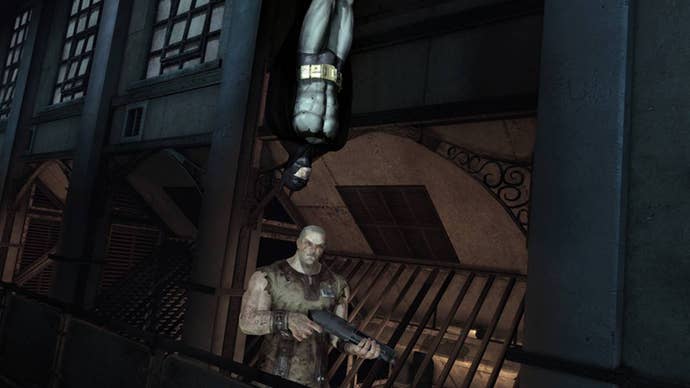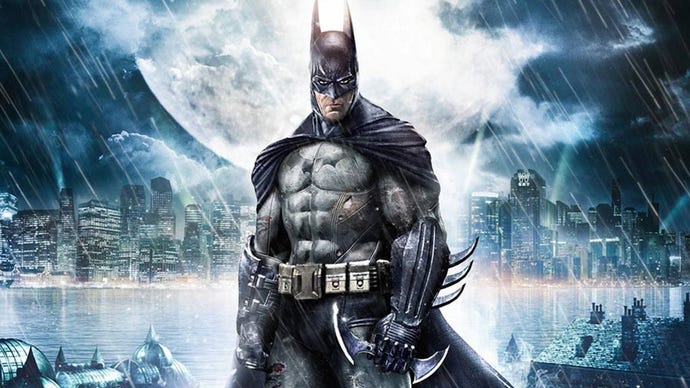10 Years Ago, Batman: Arkham Asylum Showed Us That Superhero Games Could Be More
Nothing before could capture the Dark Knight quite like Arkham.
This article first appeared on USgamer, a partner publication of VG247. Some content, such as this article, has been migrated to VG247 for posterity after USgamer's closure - but it has not been edited or further vetted by the VG247 team.
The superhero game concept seemed a lost cause before Batman: Arkham Asylum. The Marvel Cinematic Universe was still in its nascent stages, and gems like Spider-Man 2 were diamonds in the rough. Batman, most of all, saw the short end of the stick. The caped crusader was often limited to beat 'em ups more in the vein of the Adam West games than anything capturing his terrifying demeanor, detective work, or inner demons.
Ten years ago yesterday, Rocksteady's Arkham Asylum changed all that. With a touch of inspiration from the grittiness of the Christopher Nolan films and a cast backed by the critically acclaimed Batman: The Animated Series' leads, Arkham Asylum was both a collage of Batman's past and something new entirely. This wasn't a licensed film-game or crossover. It felt like a greatest hits of Batman, bringing in an entire rogue's gallery headlined by, of course, the Joker.
In just the opening minutes, the tone is set. Joker is caught and defeated. He's brought into Arkham when, in a span of minutes, the tables have turned and the inmates are loose. Batman is the one trapped inside the Asylum, tasked with re-jailing some of his great nemeses in a single night. In an interview with Engadget, lead narrative designer Paul Crocker says it helped to keep the focus not on previous Batman installments or comics, but the core of the character: "We started by focusing on: Who is Batman? What is Batman? What does Batman bring to a game?"

The world of Arkham Asylum was grim, but not without charm. Arkham Asylum's halls are imposing, stretching to uncomfortable lengths, beset by gothic architecture. Modern technology is bolted onto the old. In an interview with The Telegraph, writer Paul Dini notes how Rocksteady's own London influence played a part in making a "uniquely British" Batman.
"To some degree I don't think Batman works in a completely modern city; I think Gotham has to be reflective of his personality and those of his enemies," Dini says. "When I saw the first illustrations of Arkham Asylum for the game with the rotting weeds and the statues and crumbling brick work and the full moon over it-I just knew it was perfect because it was both of our world and not of our world. It was a place where nightmares are locked away."
In a crude sense, Arkham Asylum could be called a metroidvania. It is a world that changes throughout the night, and changes Batman along with it. As different areas open up and you fight more and more enemies, the night starts taking a visible toll on Batman. Joker's influence seeps into every corner, taunting Batman as he dives deeper into the monstrous establishment.
There were revolutionary moments, like the incredible Scarecrow game freeze or the water-logged stealth fight against the Killer Croc that still stand out as incredible setpieces. The combat for Arkham Asylum alone became a blueprint for dozens of action-brawlers to come, like Middle-Earth: Shadow of Mordor, Rise: Son of Rome, and even similarities in the recent Marvel's Spider-Man. But Arkham Asylum's true legacy was bringing the Dark Knight into the modern era with a series that understood what made him compelling.
By putting Batman in the Asylum, surrounded by his own worst enemies and alone with his inner demons, Arkham Asylum shines as a showcase for all the best and worst of the DC hero. Later games expanded the scope and gave you a Gotham to save multiple times over, but something about Arkham Asylum's relatively small scale is still striking to this day.
Batman: Arkham Asylum is, as Crocker noted, concerned with the question of who Batman is. In the time since, we've had Telltale Games deftly explore the hero's dualistic nature and other Arkham games build out the massive universe and lore of Gotham at large. But Arkham Asylum didn't care for Bruce Wayne, and it didn't look at anything outside the walls of the asylum. This was the bottle episode Batman sorely needed, and it turned into a video game series that truly lived up to the caped crusader's legend.
With Arkham series developer Rocksteady playing coy about what could be next for the studio, it seems like Batman might be patiently waiting for his next turn in the spotlight. But I'm pretty okay with that. It took years of missing the mark before a Batman game came along and got it right. I can't wait to see what a few years' rest will bring about this time.


